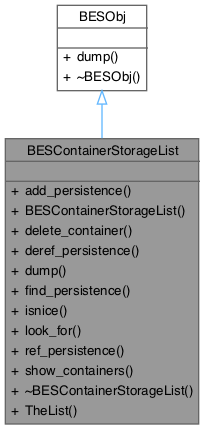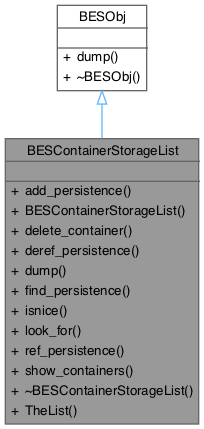Provides a mechanism for accessing container information from different container stores registered with this server. More...
#include <BESContainerStorageList.h>


Public Member Functions | |
| virtual bool | add_persistence (BESContainerStorage *p) |
| virtual void | delete_container (const std::string &sym_name) |
| virtual bool | deref_persistence (const std::string &persist_name) |
| virtual void | dump (std::ostream &strm) const |
| dump the contents of this object to the specified ostream | |
| virtual BESContainerStorage * | find_persistence (const std::string &persist_name) |
| virtual bool | isnice () |
| virtual BESContainer * | look_for (const std::string &sym_name) |
| virtual bool | ref_persistence (const std::string &persist_name) |
| virtual void | show_containers (BESInfo &info) |
Static Public Member Functions | |
| static BESContainerStorageList * | TheList () |
Detailed Description
Provides a mechanism for accessing container information from different container stores registered with this server.
This class provides a mechanism for users to access container information from different container stores, such as from a MySQL database, a file, or volatile stores.
Users can add different BESContainerStorage instances to this persistent list. Then, when a user looks for a symbolic name, that search goes through the list of persistent stores in order.
If the symbolic name is not found then a flag is checked to determine whether to simply log the fact that the symbolic name was not found, or to throw an exception of type BESContainerStorageException.
- See also
- BESContainerStorage
- BESContainer
- BESContainerStorageException
Definition at line 72 of file BESContainerStorageList.h.
Member Function Documentation
◆ dump()
|
virtual |
dump the contents of this object to the specified ostream
This method is implemented by all derived classes to dump their contents, in other words, any state they might have, private variables, etc...
The inline function below can be used to dump the contents of an OPeNDAPObj object. For example, the object Animal is derived from BESObj. A user could do the following:
Animal *a = new dog( "Sparky" ) ; cout << a << endl ;
And the dump method for dog could display the name passed into the constructor, the (this) pointer of the object, etc...
- Parameters
-
strm C++ i/o stream to dump the object to
Implements BESObj.
The documentation for this class was generated from the following file: